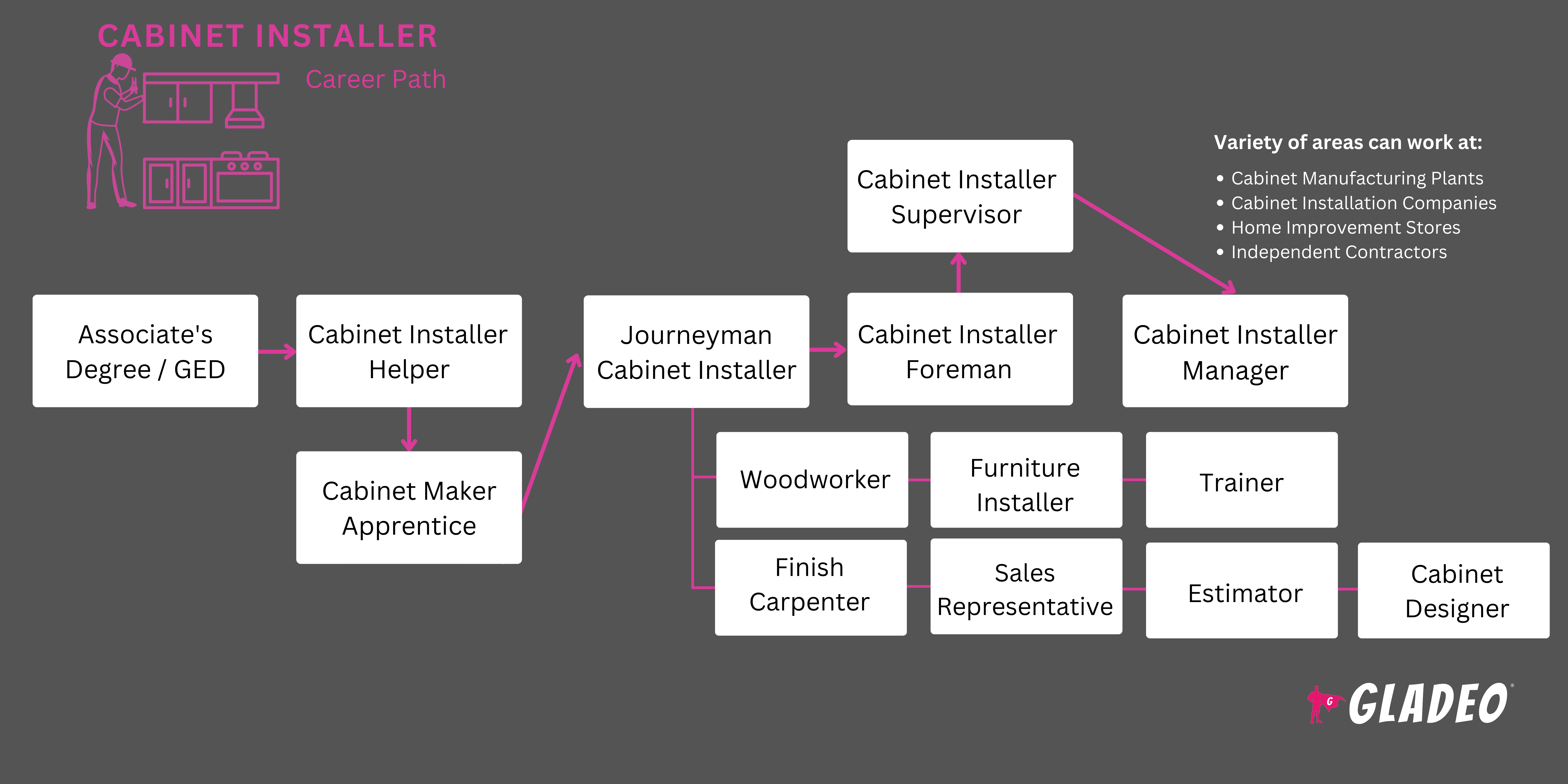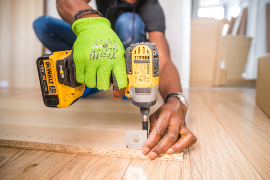Spotlights
Kitchen Installer, Millwork Installer, Carpentry Installer, Cabinetry Installation Technician, Furniture Installer, Interior Systems Installer
Imagine living in a home without any cabinets! All your glasses, dishes, silverware, pots and pans, prepackaged food, and other items would just be stacked around on the floor or in boxes. Maybe that thought makes you realize what a crucial—and overlooked—job Cabinet Installers have!
Cabinet installation is a skilled trade that involves the precise, stable placement of cabinets in all sorts of buildings. Installers don’t design or create cabinets like Cabinet Makers do, but they’re in charge of the all-important final phase of the process: the actual installation.
Cabinet Installers often collaborate with designers, architects, and clients to understand the exact installation requirements. That way they can plan ahead and make any necessary adjustments while on-site. They must be masters of various installation techniques, and able to use a range of hand tools, power tools, and materials while ensuring cabinets get installed accurately and securely.
- Adding functionality to living spaces
- Opportunities to work on a wide variety of projects
- Steady demand for services in new construction and renovation projects
Working Schedule
Cabinet Installers typically work full-time, and must frequently travel to job sites. They may work overtime when collaborating with construction teams on larger projects.
Typical Duties
- Meet with clients as needed to go over the project scope, details, timeframes, and budget
- Prepare quotes based on costs for materials, labor, etc. Respond to questions or offer clarification
- Share formal contracts for client review, approval, and signature
- Read and interpret installation blueprints, plans, and hardware needed
- Thoroughly measure and prepare installation sites. Verify the dimensions of installation areas to ensure cabinets will fit as designed
- Take into consideration plumbing fixtures, lighting, doors, appliances, etc.
- Install cabinets, ensuring they are level, secure, and properly aligned. Adjust or modify cabinets on-site for a perfect fit
- Use a variety of tools for measuring, cutting, and fastening during installation
- Install hardware (such as hinges, handles, catches, or drawer pulls) using hand tools
- Apply touch-ups to installed cabinets, if needed and qualified
- Coordinate with clients, designers, and construction teams throughout the installation process
- Clean worksite after installation; return vehicle with equipment and tools back to place of employment
- Submit invoices to clients for payment; respond to any disputes or discrepancies
Additional Responsibilities
- Account for all equipment and tools. Perform routine maintenance or repairs as needed
- Order new equipment, tools, hardware, or other supplies when necessary
- Keep accurate records of installations and materials used
- Maintain a safe working environment, adhering to safety standards
- Continuously update skills to include the latest installation techniques and tools
Soft Skills
- Accuracy
- Analytical
- Business oriented (if self-employed)
- Customer service
- Detailed-oriented
- Excellent hand-eye coordination
- Manual dexterity
- No severe dust allergies or breathing issues
- Patience
- Perseverance
- Problem-solving
- Project management
- Quality assurance
- Safety-minded
- Sound judgment and reasoning
- Strong communication skills
Technical Skills
- Assembly techniques
- Basic math calculations
- Blueprint reading
- Estimating materials and costs
- Installation and fitting techniques, such as scribing and using shims
- Installation of hardware (e.g., hinges, handles)
- Knowledge of adhesive application
- Knowledge of drawer slide installation and adjustments
- Layout and marking techniques
- Proper use of hand tools (e.g., chisels, planes, saws) and power tools (e.g., table saw, band saw, router)
- Safety procedures
- Construction firms
- Homebuilding companies
- Independent contractors
- Renovation and remodeling companies
- Retail outlets offering installation services
- Self-employed
Installing cabinets is precision work. Installers need to take their time to plan meticulously and get the job done right the first time. There are a ton of things to consider, such as taking accurate measurements, calculating ceiling height, bringing the right hardware, building around existing plumbing, considering how doors may interfere, and planning for how cabinets may impact lighting.
In addition to all the tasks to keep track of, the work can be physically demanding, too—especially when the day is running long. But there’s little margin for error, which means installers can’t take shortcuts.
If the finished project isn’t perfect, they could have to come back to fix things. Otherwise, they might have to issue a refund, risk damaging their business reputation, or even get taken to small claims court.
The integration of technology in cabinet design is a growing trend, transforming the way cabinets are installed and used.
Modern installations often include built-in charging stations, sensor-activated lighting, and advanced soft-closing mechanisms. These additions require installers to stay up-to-date on working with such components and tech features.
Another trend is the demand for eco-friendly and sustainable materials in cabinet construction. Cabinet Installers increasingly work with recycled materials, bamboo, and low-VOC finishes. While the installers don’t create the cabinets, they do need to know how to properly handle these materials.
There’s also a trend towards customized cabinetry, which calls for installers to be a bit more creative in their installation approaches due to non-standard sizes.
In their younger years, Cabinet Installers may show an affinity for hands-on activities. They might have enjoyed woodworking, crafting, or building models. In addition, they could have been very handy around the house, repairing household items or doing some light carpentry work. They’re also usually very organized and great planners!
- Cabinet Installers need a high school diploma or equivalent. A college degree is not necessary
- Note, ~17% of installers do end up completing a bachelor’s, but it’s often because they want to hone their business skills if they are self-employed
- Workers must have applicable woodworking, cabinetry, carpentry, or construction skills. These can be learned in high school classes, vocational or technical school courses, apprenticeships, part-time jobs—or a combination of these things!
- Some installers start as helpers or laborers, learning installation and fitting techniques, hardware installation, adhesive application, drawer slide installation, layout and marking techniques, blueprint reading, and the safe use of hand tools and power tools
- Because cabinet installation is a business, workers also need customer service skills, business skills, and general problem-solving skills
- Per Zippia, it takes ~6-12 months of job training to become a cabinet installer
- Safety is an integral part of this profession, so an OSHA Safety and Health Fundamentals Certificate or OSHA 10-hour training card can be helpful. Employers can usually explain the details and help workers get signed up!
- Cabinet Installers typically need a driver’s license to make it to job sites
- Cabinet Installers don’t need to go to college, but if you do take classes, consider the cost of tuition, discounts, and local scholarship opportunities (in addition to federal aid)
- Think about your schedule and flexibility when deciding whether to enroll in an on-campus, online, or hybrid program. Ideally, you’ll want as much hands-on practice as you can get for many of these cabinetry courses
- Read reviews from previous students and check out job placement stats and details about the program’s alumni network
- Note, some training programs may have connections with local employers!
- Cabinet Installers should take English, art/design, blueprint reading, general math (arithmetic, fractions, decimals, ratios, proportions), geometry, physics, drafting, computer-aided design, and woodworking or shop courses
- Gain hands-on skills under the supervision of a professional who can show you how to use hand and power tools safely
- High school students can often take community college or vocational training classes simultaneously. Your school counselor should be able to offer details
- Get practical work experience through part-time carpentry or construction jobs (or via apprenticeships or entry-level laborer positions)
- Try working on some cabinets in your garage to get practice
- Consider volunteering on local Habitat for Humanity projects
- Expand your practical knowledge through online classes, too!
- Watch related videos on YouTube channels like This Old House
- Educate yourself through cabinetry books, magazines, blogs, and discussion forums
- Ask a working Cabinet Installer if they have time to do an informational interview with you
Note, that many employers in the skilled trades, including cabinet installation, conduct pre-employment drug tests. This is because the use of hand and power tools can be hazardous, so employers and insurance companies want to reduce risks. For apprenticeships, unions may mandate pre-apprenticeship drug tests or random drug tests.

- Rack up as much relevant experience as you can in school or through volunteer work, part-time jobs, or an apprenticeship
- Check out job portals like Glassdoor, Indeed, USAJOBS, or SimplyHired
- Look for apprenticeship opportunities at Apprenticeship.gov
- Ask your school’s career services staff for help with resumes, mock interviews, and job searches. They may have connections to local unions that offer apprenticeships!
- If applying for a union apprenticeship, read the application instructions carefully before filling anything out
- Note, “most unions don’t expect you to be an expert in your industry,” when you apply for an apprenticeship,” notes Indeed
- Reach out to your network to let them know you are looking for opportunities
- Screen job ads carefully to ensure you meet the requirements
- Focus your resume on relevant work and academic experiences
- Include keywords in your resume/application, such as:
- Blueprint Reading
- Cabinet Making
- Carpentry
- Customer Service
- Detail Oriented
- Hand Tools
- Molding
- Power Tools
- Remodeling
- Saw
- Trim Carpentry
- Engage in online forums and ask career advice questions
- Ask your professors, supervisors, and peers if they’ll serve as personal references
- Review Cabinet Installer resume templates to get ideas for formatting and phrasing
- Look up common interview questions to prepare for those crucial interviews
- Always dress appropriately for job interview success!
- Be ready to meet pre-employment requirements
- Cabinet Installers can work their way up by doing consistently high-quality work, paying attention to details, being on time and ready every day, and getting projects finished on time and on budget
- Talk to your supervisor about your career goals. Let them know you are willing to knock out any training your employer suggests, such as specialized certifications
- Ask about tuition reimbursement or other employer-sponsored educational benefits to cover your expenses as you continue learning about the trade
- Always prioritize safety and never take shortcuts. One significant mishap or injury could damage your whole career!
- Challenge yourself to work on more complex projects
- Supervisor and mentor newer installers and other junior workers. Lead by example!
- Keep active in professional organizations to learn new things and grow your network
- If necessary, apply for jobs that offer more advancement potential—or launch your own business
Websites
- Apprenticeship.gov
- Associated Builders and Contractors
- Associated General Contractors of America
- Association for Manufacturing Technology
- Bridging Outstanding Opportunities with Tradeswomen Skills
- Career Connections
- Carpenters Southwest Administrative Corporation
- Carpenters Training Institute
- Helmets to Hardhats
- Home Builders Institute
- Job Corps
- National Association of the Remodeling Industry
- National Building Trades Union
- NCCER
- Sisters in the Brotherhood
- United Brotherhood of Carpenters and Joiners of America
- United Brotherhood of Carpenters and Joiners of America, Carpenters Training Fund
- Western States Carpenters
- Wood Industry Resource Collaborative
- Woodwork Career Alliance of North America
- Woodworking Machinery Industry Association
Books
- Building Kitchen Cabinets: Taunton's BLP: Expert Advice from Start to Finish, by Udo Schmidt
- Constructing Kitchen Cabinets (Back to Basics), by Skills Institute Press
- Installing Kitchen Cabinets Made Simple, by Gregory Paolini
Cabinetmaking is becoming more automated these days, but it could be a long time before the actual installation process can be automated. That’s why there should remain a solid demand for Cabinet Installers in the coming years.
But if you want to explore other options, below are some related occupations to consider!
- Building Maintenance Worker
- Carpenter
- Construction and Building Inspector
- Construction Worker
- Drywall Installer
- Flooring Installer
- Furniture Assembler
- Home Inspector
- Insulation Worker
- Model Installer
- Renovation Specialist
- Roofer
- Solar Photovoltaic Installer
- Structural Metal Fabricator and Fitter
- Tile and Stone Setter
- Woodworking Machine Setter
Newsfeed

Featured Jobs

Online Courses and Tools

Annual Salary Expectations
New workers start around $45K. Median pay is $55K per year. Highly experienced workers can earn around $71K.





